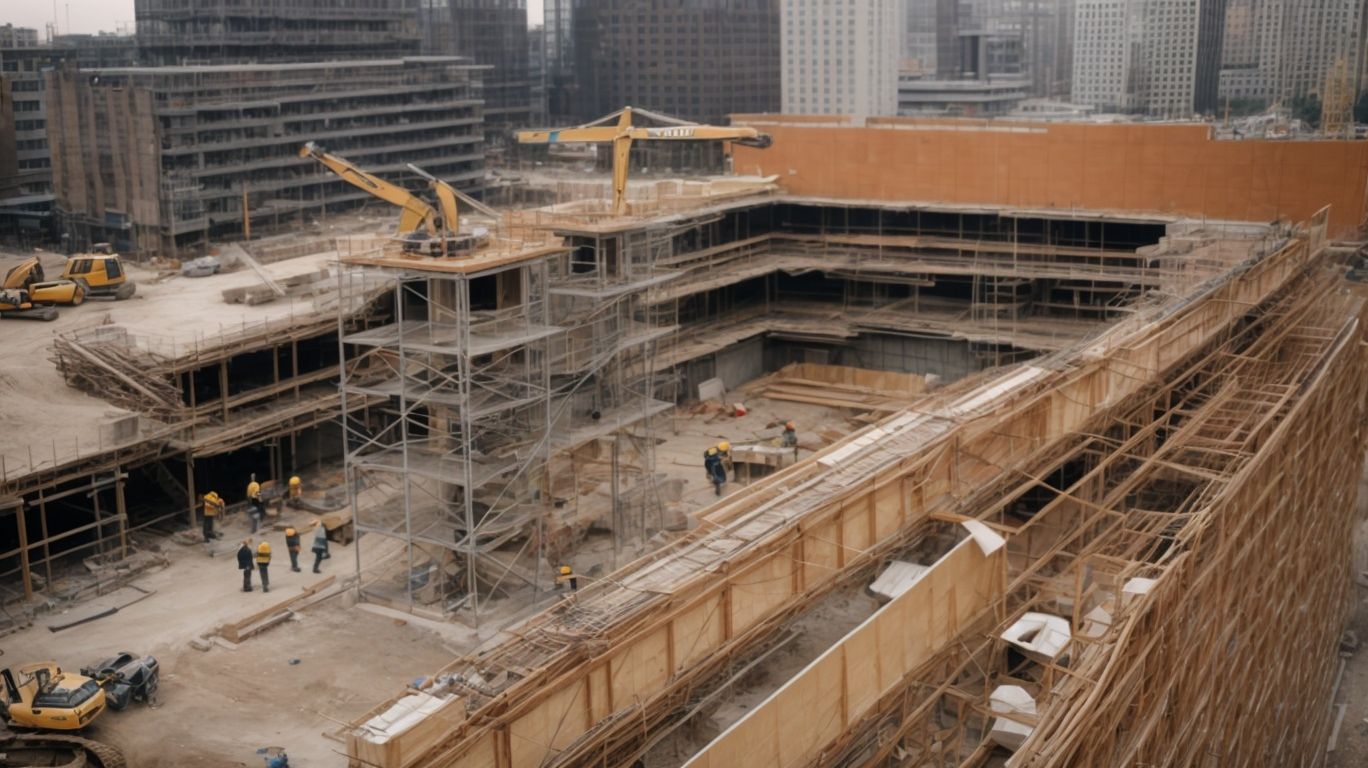
Common Challenges and Solutions During Retrofit Projects
Retrofit projects are becoming increasingly popular as property owners seek to improve energy efficiency, increase property value, and enhance safety and comfort.
These projects come with their own set of challenges, including budget constraints, time constraints, lack of communication, and inadequate planning.
In this article, we will explore these common challenges and provide practical solutions to overcome them. We will discuss the benefits of retrofit projects and some common solutions, such as energy-efficient upgrades, building envelope improvements, HVAC system upgrades, and lighting upgrades.
If you’re considering a retrofit project, this article will provide valuable insights to help you navigate the process successfully.
What are Retrofit Projects?
Retrofit projects involve the renovation and enhancement of existing structures, buildings, or facilities to meet current standards and improve their overall performance in terms of construction, engineering, and environmental impact.
This type of renovation is commonly seen in various building types, including residential homes, commercial spaces, industrial facilities, and public infrastructure.
For instance, in the residential sector, retrofitting may include upgrading insulation, installing energy-efficient windows, or upgrading HVAC systems.
In commercial buildings, retrofit projects can involve modernizing lighting systems, improving air quality, and incorporating sustainable materials.
Industrial facilities often undergo retrofitting to enhance energy efficiency, optimize production processes, and ensure compliance with environmental regulations.
The success of retrofit projects relies on sound engineering, advanced construction techniques, and a strong focus on sustainability and environmental responsibility.
What are the Common Challenges in Retrofit Projects?
Undertaking retrofit projects comes with various common challenges that span across compliance with codes, budgeting, timeline management, and effective communication among stakeholders and contractors.
One of the primary challenges in retrofit projects is complying with building codes and regulations. This can be complex, especially when working with existing structures, as the project must meet the standards set by the local building authority.
Budgeting is also a crucial aspect, as funds must be allocated for unforeseen structural issues or material delays. Efficient timeline management is essential to avoid project delays and associated costs. Communication breakdowns among stakeholders and contractors can lead to misunderstandings and inefficiencies, which can greatly impact the project’s overall success.
Budget Constraints
Budget constraints present a significant challenge in retrofit projects, requiring meticulous cost management and resource allocation to ensure the successful execution of renovation and construction efforts within the allocated budget.
Implementing effective cost management strategies becomes imperative in such scenarios. Optimal resource allocation, rigorous assessment of material and labor costs, and the integration of cost-effective alternatives are essential.
Harnessing technology for efficiency, negotiating favorable contracts, and fostering collaboration among project stakeholders can further streamline expenses. By prioritizing value and sustainability, retrofits can navigate budget limitations and achieve impactful results, emphasizing the importance of strategic decision-making and adaptability in the face of financial constraints.
Time Constraints
Managing time constraints is a critical aspect of retrofit projects. This requires efficient timeline planning and coordination among various stakeholders, contractors, and permitting and inspection processes to ensure project completion within specified timeframes.
This entails aligning the schedules of different trades, such as plumbing, electrical, and HVAC, to avoid delays and ensure smooth progress.
Stakeholder coordination becomes paramount, with constant communication and clear expectations to minimize disruptions.
Strategies for streamlining permitting and inspection processes, such as leveraging digital platforms for documentation and approvals, play a pivotal role in expediting the project timeline while adhering to regulatory requirements.
This comprehensive approach helps to optimize time management in retrofit projects and achieve successful outcomes.
Lack of Communication
The lack of effective communication can impede the progress of retrofit projects, highlighting the critical need for clear and consistent communication channels among stakeholders, contractors, and project teams to ensure seamless coordination and decision-making.
This emphasizes the importance of fostering an environment where all involved parties are actively engaged in the communication process.
When communication gaps occur, it can lead to misunderstandings, delays, and errors in project implementation. Proactive measures such as regular meetings, progress updates, and clear documentation can mitigate these challenges.
It’s essential for stakeholders to be kept informed about the project’s status, potential risks, and any changes, ensuring their active participation and support throughout the retrofit process.
Inadequate Planning
Inadequate planning poses a significant challenge in retrofit projects, emphasizing the critical role of comprehensive planning and risk assessment to mitigate potential setbacks and ensure the smooth execution of renovation and construction activities.
This lack of meticulous preparation can lead to project delays, cost overruns, and compromised safety standards. Thorough risk assessment is essential to identify potential hazards and develop proactive strategies to address them.
In addition, contingency planning is crucial to anticipate and mitigate unexpected issues. Adaptive strategies enable teams to respond effectively to unforeseen challenges, enhancing the project’s resilience and success. By integrating these measures, stakeholders can navigate the complexities of retrofit projects with greater confidence and efficiency.
How to Overcome these Challenges?
To optimize readability and SEO, it’s advisable to break paragraphs into concise, easily digestible sentences. Add
tags to the text given and aim for a maximum of two sentences per
tag section, allowing multiple
tags. This approach enhances user experience and search engine indexing. Also, add tags to important keywords and phrases, and tags for quotes.
Overcoming the challenges in retrofit projects requires proactive measures such as creating a detailed budget plan, setting realistic timelines, establishing effective communication channels, and conducting thorough planning and risk assessment to drive informed decision-making and problem-solving.
This comprehensive approach ensures that the project remains within budget and on schedule, while also minimizing potential disruptions.
Leveraging advanced technologies and sustainable practices can significantly improve energy efficiency and reduce environmental impact in retrofit projects.
Collaborating with experienced industry professionals and staying updated with the latest regulations and guidelines can further streamline the process, enhance safety measures, and deliver high-quality outcomes that meet the evolving needs and expectations of the stakeholders involved.
Create a Detailed Budget Plan
Creating a detailed budget plan is essential in overcoming budget constraints in retrofit projects. This involves meticulous cost analysis, resource allocation, and the integration of cost-effective materials and labor to optimize project finances.
This process begins by conducting thorough cost analysis to identify all potential expenses. It is followed by resource optimization through careful planning and prioritization. Strategic allocation of financial resources ensures that the budget plan aligns with the project’s objectives, allowing for flexibility and contingency measures.
Integrating cost-effective materials and labor not only helps in reducing overall expenditure, but also enhances the sustainability and efficiency of the project.
Set Realistic Timelines
Setting realistic timelines is crucial to overcome time constraints in retrofit projects. This requires comprehensive timeline planning, stakeholder coordination, and proactive management of permitting and inspection processes to ensure timely project completion.
To optimize readability and SEO, it’s advisable to break paragraphs into concise, easily digestible sentences. This can be achieved by adding <p> tags to the text and aiming for a maximum of two sentences per <p> tag section. This approach enhances user experience and improves search engine indexing.
One key aspect of successful project management is aligning all stakeholders early on in the project. This helps establish clear expectations and minimizes potential delays. Additionally, efficient project scheduling is crucial, which involves identifying critical path activities and potential bottlenecks that could impact timelines.
Another important factor in streamlining retrofit projects is understanding and navigating regulatory requirements. This includes proactive engagement with relevant authorities to expedite approvals. By integrating these strategies, project managers can minimize the impact of unforeseen challenges and deliver projects within set timelines.
Establish Effective Communication Channels
Establishing effective communication channels is pivotal in overcoming the challenges of inadequate communication in retrofit projects. This necessitates the implementation of clear and collaborative communication platforms to facilitate seamless stakeholder engagement and decision-making.
This can be achieved through proactive communication measures that involve regular updates, feedback mechanisms, and the use of various communication tools such as project management software, virtual meetings, and dedicated communication channels. By integrating these strategies, project teams can ensure that all stakeholders are informed, involved, and empowered to contribute to the success of retrofit projects. This leads to improved efficiency, reduced conflicts, and enhanced overall project outcomes.
Conduct Thorough Planning and Risk Assessment
Conducting thorough planning and risk assessment is imperative to overcome the challenges of inadequate planning in retrofit projects. This requires comprehensive risk analysis, contingency planning, and adaptive strategies to address potential setbacks.
This process involves a deep understanding of the project’s objectives, constraints, and potential risks. It allows for the development of proactive measures to mitigate any unforeseen challenges. By integrating relevant stakeholders and experts, adaptive strategies can be formulated to ensure flexibility in response to changing conditions. A comprehensive risk analysis enables project managers to identify and address vulnerabilities, thus fostering resilience in the face of uncertainties. The careful consideration of potential risks and the adoption of proactive measures are essential for the successful execution of retrofit projects.
What are the Benefits of Retrofit Projects?
Retrofit projects offer a range of benefits, including improved energy efficiency, increased property value, enhanced safety and comfort, and reduced maintenance and operating costs, making them a valuable investment in building and infrastructure improvement.
Improving energy efficiency through retrofits can lead to substantial cost savings for building owners and occupants. For instance, installing energy-efficient lighting and HVAC systems can significantly reduce energy consumption, resulting in lower utility bills.
Enhancing safety with upgrades such as fire-resistant materials and improved security systems not only provides peace of mind for occupants but also adds value to the property.
These benefits make retrofit projects a strategic choice for long-term sustainable property management.
Improved Energy Efficiency
Retrofit projects contribute to improved energy efficiency, driving positive environmental impact through the integration of energy-efficient upgrades and technologies that optimize resource consumption and reduce carbon footprint.
This proactive approach not only enhances operational sustainability but also mitigates the strain on natural resources.
By embracing energy-efficient solutions, businesses and households can significantly reduce their carbon emissions, fostering a greener and healthier environment.
Improved energy efficiency leads to long-term cost savings, making it an economically viable investment.
It also facilitates a shift towards a more sustainable energy landscape, aligning with global efforts to combat climate change and promote eco-friendly living.
Increased Property Value
Retrofit projects lead to increased property value, enhancing the aesthetic appeal, structural integrity, and performance of buildings and facilities through strategic renovation and construction efforts, offering long-term financial benefits and market competitiveness.
Integrating modern building practices, such as energy-efficient technologies and sustainable materials, can lead to significant cost savings on utilities and maintenance for property owners. It also contributes to environmental conservation.
Structural enhancements not only improve safety and durability but also increase the overall value and desirability of the property. These upgrades attract potential buyers or tenants seeking modern, efficient, and sustainable spaces, leading to increased demand and higher property values.
Enhanced Safety and Comfort
Retrofit projects deliver enhanced safety and comfort, emphasizing the importance of rigorous quality control, maintenance, and the integration of modern technologies to ensure the well-being and satisfaction of occupants and users within renovated buildings and facilities.
These initiatives are essential to uphold strict safety standards and promote a sense of security for occupants.
Quality control measures are crucial in ensuring that renovated structures meet and exceed regulatory requirements. Careful maintenance protocols play a vital role in preserving the longevity and optimal functionality of upgraded systems and amenities.
Integrating modern technologies, such as advanced security systems and energy-efficient solutions, significantly enhances the overall comfort and usability of rehabilitated spaces.
Reduced Maintenance and Operating Costs
Retrofit projects result in reduced maintenance and operating costs, emphasizing the impact of efficient maintenance protocols, technology integrations, and sustainable practices that optimize resource utilization and minimize long-term operational expenses.
These initiatives lead to significant savings by streamlining maintenance processes, integrating advanced technologies for predictive maintenance, and promoting sustainable strategies that reduce energy consumption and waste generation.
By implementing efficient maintenance protocols, organizations can enhance equipment reliability, extend asset lifecycles, and lower overall maintenance expenses. The integration of smart technologies and automation not only improves operational efficiency but also contributes to cost reductions through optimized resource allocation and minimized downtime.
What are the Common Solutions for Retrofit Projects?
Common solutions for retrofit projects include energy-efficient upgrades, building envelope improvements, HVAC system upgrades, and lighting upgrades, offering comprehensive strategies to enhance the performance and sustainability of existing structures and facilities.
Energy-efficient upgrades cover a wide array of improvements such as insulation, windows, and renewable energy systems.
Upgrading windows to energy-efficient ones can significantly reduce heat loss, lowering the need for heating and air conditioning. Building envelope enhancements involve sealing air leaks, improving insulation, and optimizing roof systems, which can lead to substantial energy savings.
HVAC system upgrades encompass replacing outdated equipment with more efficient models, integrating smart controls, and optimizing ventilation. Similarly, lighting upgrades can involve switching to LED fixtures, sensors, and daylight harvesting to reduce energy consumption.
Energy-efficient Upgrades
Energy-efficient upgrades play a pivotal role in retrofit projects, driving positive environmental impact and resource optimization through the integration of advanced technologies and sustainable practices.
These upgrades not only reduce energy consumption and minimize environmental footprint but also contribute to the overall conservation of resources.
The utilization of innovative technologies such as smart thermostats, LED lighting, and energy-efficient appliances showcases the progressive shift towards more sustainable and eco-friendly solutions.
The implementation of sustainable practices such as efficient insulation and renewable energy sources further accentuates the overall positive impact on the environment and promotes a more responsible approach to energy management.
Building Envelope Improvements
Building envelope improvements contribute to the structural and engineering enhancements in retrofit projects, emphasizing innovative solutions and adaptive practices that optimize building performance, durability, and environmental compatibility.
These improvements have a direct impact on the overall energy efficiency of buildings, reducing heat loss and air leakage while enhancing thermal comfort.
By implementing advanced materials and construction techniques, the building envelope serves as a critical interface between the interior and exterior environments, effectively regulating temperature, humidity, and air quality.
The integration of sustainable design principles in building envelope improvements facilitates resource conservation and promotes a more eco-friendly built environment, aligning with the growing emphasis on green building practices and societal sustainability goals.
HVAC System Upgrades
HVAC system upgrades are fundamental in retrofit projects, emphasizing the integration of energy-efficient technologies, adaptive systems, and technological innovations that enhance indoor air quality, comfort, and operational efficiency.
Upgrades to HVAC systems are essential for reducing energy consumption and improving performance. Advanced control systems and sensors allow for adaptation to changing environmental conditions, ensuring precise regulation of temperature, humidity, and air distribution.
Integrating smart thermostats and variable speed motors can greatly enhance energy efficiency, resulting in cost savings and environmental benefits. These upgrades pave the way for more sustainable and eco-friendly building operations in the long run.
Lighting Upgrades
Lighting upgrades play a crucial role in retrofit projects, emphasizing the integration of innovative lighting technologies, sustainable practices, and energy-efficient solutions that optimize illumination, ambiance, and energy consumption.
Upgrading fixtures goes beyond simply replacing old ones with new ones. It also has a significant impact on energy savings, maintenance costs, and environmental sustainability.
One way to further improve energy efficiency is by utilizing advanced lighting controls, such as motion sensors and dimmers. These can greatly enhance the overall efficiency of businesses and organizations.
The use of LED technology has revolutionized the lighting industry, providing longer lifespan, lower energy consumption, and better quality illumination. By implementing these sustainable and energy-efficient solutions, retrofit projects can significantly reduce operational expenses while also contributing to a greener and more eco-friendly future.




No Comments